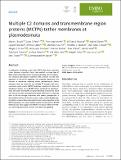Files in this item
Multiple C2 domains and Transmembrane region Proteins (MCTPs) tether membranes at plasmodesmata
Item metadata
| dc.contributor.author | Brault, Marie L. | |
| dc.contributor.author | Petit, Jules D. | |
| dc.contributor.author | Immel, Françoise | |
| dc.contributor.author | Nicolas, William J. | |
| dc.contributor.author | Glavier, Marie | |
| dc.contributor.author | Brocard, Lysiane | |
| dc.contributor.author | Gaston, Amèlia | |
| dc.contributor.author | Fouché, Mathieu | |
| dc.contributor.author | Hawkins, Timothy J. | |
| dc.contributor.author | Crowet, Jean-Marc | |
| dc.contributor.author | Grison, Magali S. | |
| dc.contributor.author | Germain, Véronique | |
| dc.contributor.author | Rocher, Marion | |
| dc.contributor.author | Kraner, Max | |
| dc.contributor.author | Alva, Vikram | |
| dc.contributor.author | Claverol, Stéphane | |
| dc.contributor.author | Paterlini, Andrea | |
| dc.contributor.author | Helariutta, Ykä | |
| dc.contributor.author | Deleu, Magali | |
| dc.contributor.author | Lins, Laurence | |
| dc.contributor.author | Tilsner, Jens | |
| dc.contributor.author | Bayer, Emmanuelle M. | |
| dc.date.accessioned | 2019-07-10T10:30:02Z | |
| dc.date.available | 2019-07-10T10:30:02Z | |
| dc.date.issued | 2019-08-01 | |
| dc.identifier | 259334003 | |
| dc.identifier | d4917eb8-de8b-421a-b97d-4a2674321825 | |
| dc.identifier | 000478756000020 | |
| dc.identifier | 85068713290 | |
| dc.identifier.citation | Brault , M L , Petit , J D , Immel , F , Nicolas , W J , Glavier , M , Brocard , L , Gaston , A , Fouché , M , Hawkins , T J , Crowet , J-M , Grison , M S , Germain , V , Rocher , M , Kraner , M , Alva , V , Claverol , S , Paterlini , A , Helariutta , Y , Deleu , M , Lins , L , Tilsner , J & Bayer , E M 2019 , ' Multiple C2 domains and Transmembrane region Proteins (MCTPs) tether membranes at plasmodesmata ' , EMBO Reports , vol. 20 , no. 8 , e47182 . https://doi.org/10.15252/embr.201847182 | en |
| dc.identifier.issn | 1469-221X | |
| dc.identifier.other | ORCID: /0000-0003-3873-0650/work/60630844 | |
| dc.identifier.uri | https://hdl.handle.net/10023/18065 | |
| dc.description | Funding: Work in J.T, lab is supported by grant BB/M007200/1 from the U.K. Biotechnology and Biomedical Sciences Research Council (BBSRC) and by the Scottish Government's Rural and Environment Science and Analytical Services Division (RESAS). | en |
| dc.description.abstract | In eukaryotes, membrane contact sites (MCS) allow direct communication between organelles. Plants have evolved a unique type of MCS, inside intercellular pores, the plasmodesmata, where endoplasmic reticulum (ER)–plasma membrane (PM) contacts coincide with regulation of cell‐to‐cell signalling. The molecular mechanism and function of membrane tethering within plasmodesmata remain unknown. Here, we show that the multiple C2 domains and transmembrane region protein (MCTP) family, key regulators of cell‐to‐cell signalling in plants, act as ER‐PM tethers specifically at plasmodesmata. We report that MCTPs are plasmodesmata proteins that insert into the ER via their transmembrane region while their C2 domains dock to the PM through interaction with anionic phospholipids. A Atmctp3/Atmctp4 loss of function mutant induces plant developmental defects, impaired plasmodesmata function and composition, while MCTP4 expression in a yeast Δtether mutant partially restores ER‐PM tethering. Our data suggest that MCTPs are unique membrane tethers controlling both ER‐PM contacts and cell‐to‐cell signalling. | |
| dc.format.extent | 26 | |
| dc.format.extent | 5475908 | |
| dc.language.iso | eng | |
| dc.relation.ispartof | EMBO Reports | en |
| dc.subject | Plasmodesmata | en |
| dc.subject | Intracellular communication in plants | en |
| dc.subject | ER-PM membrane contact sites | en |
| dc.subject | Multiple C2 domains transmembrane region proteins | en |
| dc.subject | QH301 Biology | en |
| dc.subject | DAS | en |
| dc.subject | BDC | en |
| dc.subject | R2C | en |
| dc.subject | ~DC~ | en |
| dc.subject.lcc | QH301 | en |
| dc.title | Multiple C2 domains and Transmembrane region Proteins (MCTPs) tether membranes at plasmodesmata | en |
| dc.type | Journal article | en |
| dc.contributor.sponsor | BBSRC | en |
| dc.contributor.institution | University of St Andrews. Biomedical Sciences Research Complex | en |
| dc.contributor.institution | University of St Andrews. School of Biology | en |
| dc.identifier.doi | 10.15252/embr.201847182 | |
| dc.description.status | Peer reviewed | en |
| dc.identifier.url | https://www.embopress.org/doi/10.15252/embr.201847182#support-information-section | en |
| dc.identifier.grantnumber | BB.M007200/1 | en |
This item appears in the following Collection(s)
Items in the St Andrews Research Repository are protected by copyright, with all rights reserved, unless otherwise indicated.

